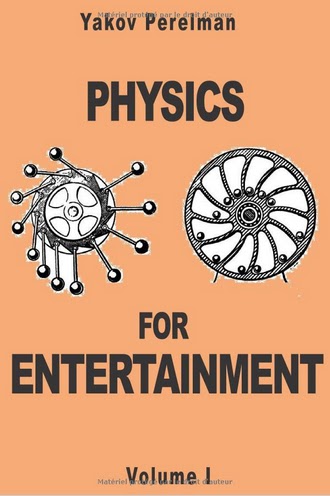Have you ever wondered why you wouldn’t feel the burn if your arm could extend and reach the Sun? Why maternity clinics would be needed on future interplanetary vessels? Why extraterrestrials, if they exist, would be very different from how they are depicted in science fiction movies? Why these extraterrestrials may have originated from our Earth? This book tries to answer these questions and many others using a scientific approach in a witty style.
First published in 1915, a best-seller in the 1920s and long out of print, Interplanetary Travel is a short excursion into space physics. Using conundrums, entertaining examples, and unexpected comparisons, Yakov Perelman dispelled some of the public prejudice that prevailed against celestial mechanics and physics of being too abstract and unable to nourish the mind. He explored, in a witty style, the opportunity of successfully completing the flights imagined in some novelists’ wildest fantasies. He checked and corrected their boldest ideas. Even today, this book remains a reference for science students around the world.
This book is a collection of several physics and mathematics experiments. Many of them are simple pastimes meant for the recreation of young and old, assembled round the family table. Others, on the contrary, being of a really scientific character, are designed to introduce the reader to the study of Physics and mathematics. Regardless of their nature, all the experiments can be carried out without any special apparatus and are consequently without the least expense. Instruments used include kitchen utensils, corks, matches, glasses, and plates. The book is very useful for the young physicist who wishes to entertain his friends. It will show him not only how to do things by which he can render himself more entertaining than the best talker or the best joker in the company, but will reveal to him a hundred things by which he can amuse and astonish everybody he knows. The book is equally useful for the teacher who wishes to create in his students an interest in science. It will enable him to illustrate scientific principles, and render his instructions as interesting as an Arabian tale.
Published in 1913, a best-seller in the 1930s and long out of print, Physics for Entertainment was translated from Russian into many languages and influenced science students around the world. Among them was Grigori Yakovlevich Perelman, the Russian mathematician (unrelated to the author), who solved the Poincaré conjecture, and who was awarded and rejected the Fields Medal. Grigori’s father, an electrical engineer, gave him Physics for Entertainment to encourage his son’s interest in mathematics. In the foreword, the book’s author describes the contents as “conundrums, brain-teasers, entertaining anecdotes, and unexpected comparisons,” adding, “I have quoted extensively from Jules Verne, H. G. Wells, Mark Twain and other writers, because, besides providing entertainment, the fantastic experiments these writers describe may well serve as instructive illustrations at physics classes.” The book’s topics included how to jump from a moving car, and why, “according to the law of buoyancy, we would never drown in the Dead Sea.” Ideas from this book are still used by science teachers today.
You don’t know that much about mathematics and physics. You don’t understand everything about rockets, satellites, or interplanetary flights. But you dream of flying to other planets and want to know everything needed to do it. You want to understand the principles of rockets and spaceships. You want to know why extraterrestrial space stations are needed and why studying other planets helps us understand our Earth. This book simply and clearly answers these questions and much more.
This is another book is Yakov Perelman's successful series of science books. Presented in an easy form, well within the reach of most astronomy amateurs, it is useful introduction to this science. Through five key chapters (the Earth, the Moon, planets, stars, and gravitation), the author analyses the most important aspects of modern astronomy.
The purpose of the book is to initiate the reader into the basic facts of astronomy. Ordinary facts with which you may be acquainted are couched here in unexpected paradoxes, or slanted from an odd and unexpected angle. The theme is, as far as possible, free from “terminology” and technical concepts that so often make the reader shy of books on astronomy. The book contains chapters relating to the Earth, the Moon and other planets. The author has concentrated on materials not usually discussed in works of this nature. This book is written in a witty style and remains a reference for astronomy students around the world.
This book contains hundreds of colorful stories from the field of physics. Despite their entertaining appearance, they address several important and serious notions in this field. This book does not seek to replace school textbooks. Its purpose is to entice the reader to consciously observe physical phenomena, including the simplest ones which we have learned to ignore in our everyday life. It allows the reader to amass evidence about physical laws, and engage in a systematic study of physics.
You don’t know that much about physics. You don’t understand everything about gravity, magnetism, electricity or light, but you are curious and want to know more about these fields. This book helps you reaching this objective using many instructive and entertaining experiments. These are simple enough to be carried out using everyday objects at home or around it. They will fascinate not only teenagers but also adults who want to understand some of nature’s fundamental laws and use them in their daily lives.
Fun with Maths and Physics details a large number of intriguing physics experiments, entertaining mathematics problems, and amazing optical illusions. The book’s main objective is to arouse the reader’s scientific imagination, teach him to think in a scientific manner, and create in his mind a variety of associations between physical knowledge and a large number of real daily life observations. Immensely instructive and entertaining, it has been one of the best sellers in Russia during the first part of last century.

















